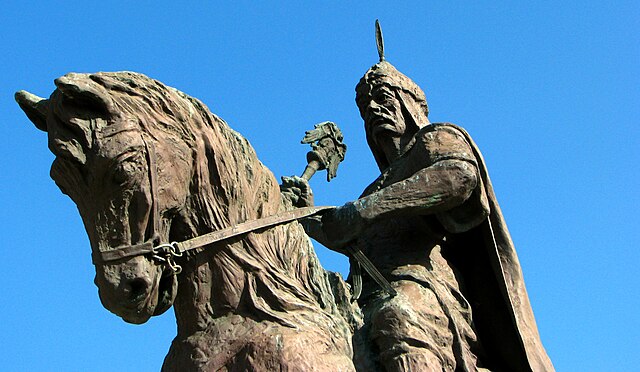Alā ad-Dīn Kayqubād ibn Kaykhusraw, also known as Kayqubad I, was the Seljuq Sultan of Rûm who reigned from 1220 to 1237. He expanded the borders of the sultanate at the expense of his neighbors, particularly the Mengujek Beylik and the Ayyubids, and established a Seljuq presence on the Mediterranean with his acquisition of the port of Kalon Oros, later renamed Ala'iyya in his honor. The sultan, sometimes styled Kayqubad the Great, is remembered today for his rich architectural legacy and the brilliant court culture that flourished under his reign.
Coinage of Ala' al-Din Kay Qubad I, Ankuriyya, 1219-1237
The Kızıl Kule, or Red Tower, built in Alanya by Kayqubad I
The Yivli Minare Mosque, built in Antalya by Kayqubad I
Modern statue of Kaykubad I in Alanya
The Seljuk dynasty, or Seljukids, Seljuqs, also known as Seljuk Turks, Seljuk Turkomans or the Saljuqids, was an Oghuz Turkic, Sunni Muslim dynasty that gradually became Persianate and contributed to Turco-Persian culture in West Asia and Central Asia. The Seljuks established the Seljuk Empire (1037–1194), the Sultanate of Kermân (1041–1186) and the Sultanate of Rum (1074–1308), which stretched from Iran to Anatolia and were the prime targets of the First Crusade.
Double-headed eagle, used as a symbol by several Seljuk rulers including Kayqubad I
Head of Seljuk male royal figure, 12–13th century, from Iran. Carved and drilled stone with Iranian craftsmanship. Kept at the New York Metropolitan Museum of Art.
Toghrol Tower, a 12th-century monument south of Tehran commemorating Toğrül
The Kharāghān twin towers, built in Iran in 1053 to house the remains of Seljuk princes








